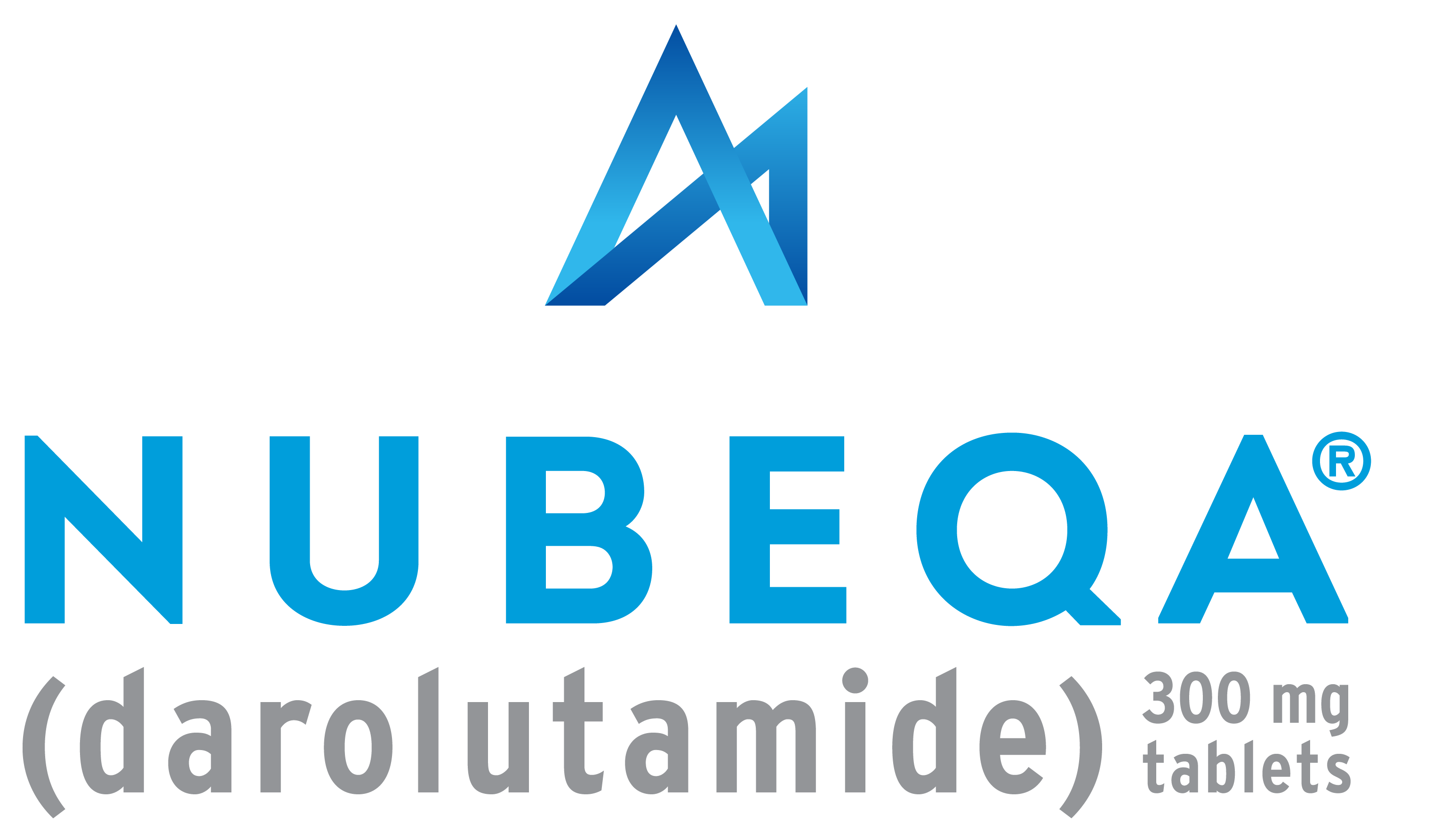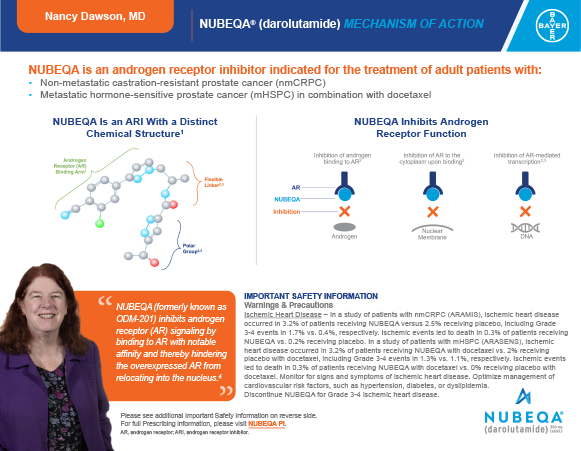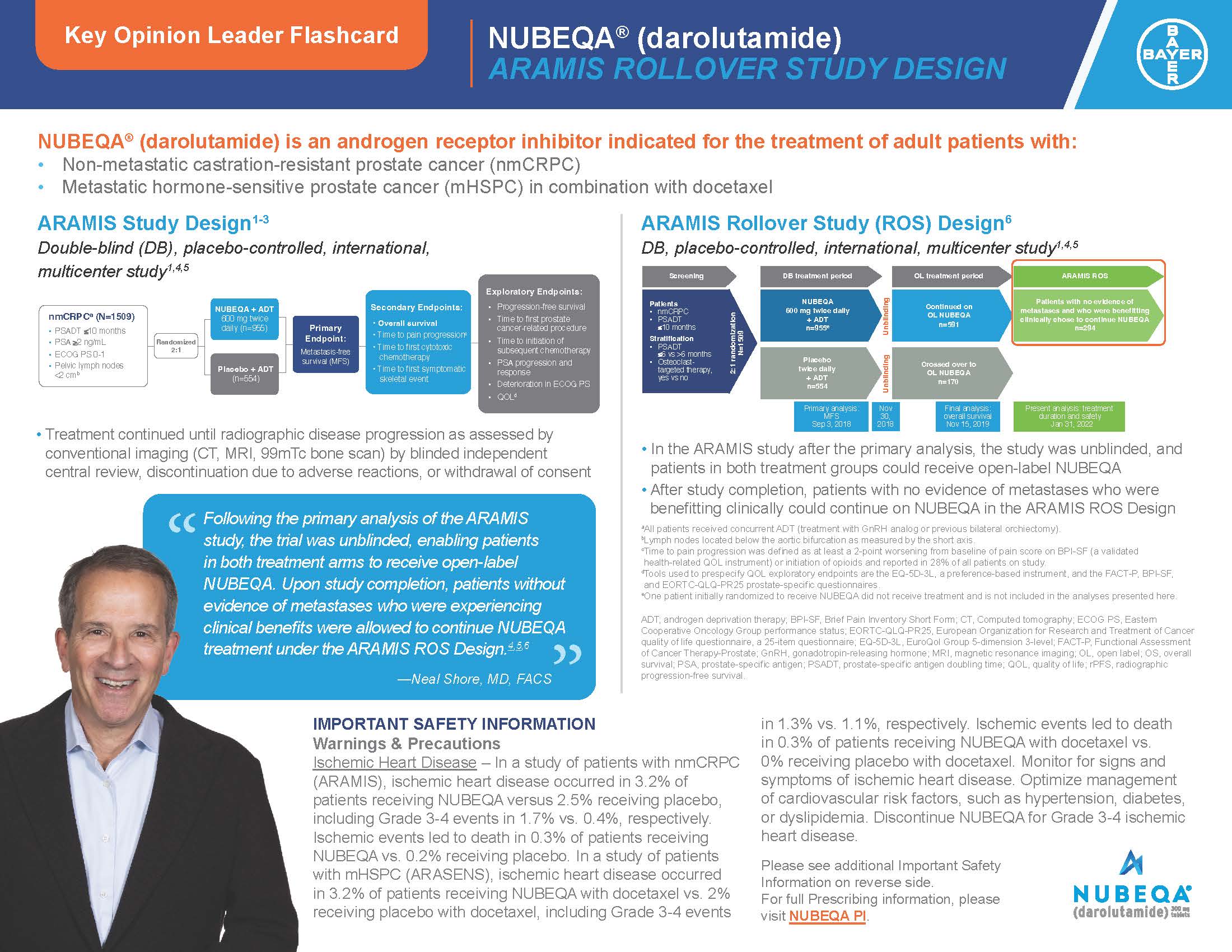
KOL FLASH CARDS
To request printed copies of one or more of the flash cards below, visit our Contact a Bayer Representative page.
VIDEOS
Click on the image to launch the video.
For optimal viewing, we recommend viewing in full-screen mode on a desktop or laptop computer.
Results of the Phase 3 ARASENS Study: A Brief Overview
Watch as Matthew Smith, MD, PhD, a principal investigator for the ARASENS trial, outlines the design, patient demographics, and findings from the phase 3 study evaluating NUBEQA in combination with docetaxel for treatment of mHSPC.
Understanding the NUBEQA Mechanism of Action
In this short video, Nancy Dawson, MD, a medical oncologist with extensive experience in prostate cancer care, provides a concise-yet-comprehensive explanation of how NUBEQA inhibits androgen receptor function.
Counseling Patients With mHSPC About Treatment With NUBEQA in Combination With Docetaxel
Hear insights from Nancy Dawson, MD, who was involved in some of the first chemotherapy trials in prostate cancer, on counseling patients about the reasons for and practical aspects of employing NUBEQA in combination with docetaxel to treat mHSPC.
Drug-Drug Interaction Considerations When Prescribing NUBEQA: An nmCRPC Patient Case
Tune in as Paul Sieber, MD, FACS, reviews the available information on NUBEQA regarding drug interactions with frequently prescribed concomitant medications and evaluates the implications for patient management.
Indications
NUBEQA® (darolutamide) is an androgen receptor inhibitor indicated for the treatment of adult patients with:
- Non-metastatic castration-resistant prostate cancer (nmCRPC)
- Metastatic hormone-sensitive prostate cancer (mHSPC) in combination with docetaxel
Important Safety Information
Warnings & Precautions
Ischemic Heart Disease – In a study of patients with nmCRPC (ARAMIS), ischemic heart disease occurred in 3.2% of patients receiving NUBEQA versus 2.5% receiving placebo, including Grade 3-4 events in 1.7% vs. 0.4%, respectively. Ischemic events led to death in 0.3% of patients receiving NUBEQA vs. 0.2% receiving placebo. In a study of patients with mHSPC (ARASENS), ischemic heart disease occurred in 3.2% of patients receiving NUBEQA with docetaxel vs. 2% receiving placebo with docetaxel, including Grade 3-4 events in 1.3% vs. 1.1%, respectively. Ischemic events led to death in 0.3% of patients receiving NUBEQA with docetaxel vs. 0% receiving placebo with docetaxel. Monitor for signs and symptoms of ischemic heart disease. Optimize management of cardiovascular risk factors, such as hypertension, diabetes, or dyslipidemia. Discontinue NUBEQA for Grade 3-4 ischemic heart disease.
Seizure – In ARAMIS, Grade 1-2 seizure occurred in 0.2% of patients receiving NUBEQA vs. 0.2% receiving placebo. Seizure occurred 261 and 456 days after initiation of NUBEQA. In ARASENS, seizure occurred in 0.6% of patients receiving NUBEQA with docetaxel, including one Grade 3 event, vs. 0.2% receiving placebo with docetaxel. Seizure occurred 38 to 340 days after initiation of NUBEQA. It is unknown whether anti-epileptic medications will prevent seizures with NUBEQA. Advise patients of the risk of developing a seizure while receiving NUBEQA and of engaging in any activity where sudden loss of consciousness could cause harm to themselves or others. Consider discontinuation of NUBEQA in patients who develop a seizure during treatment.
Embryo-Fetal Toxicity – Safety and efficacy of NUBEQA have not been established in females. NUBEQA can cause fetal harm and loss of pregnancy. Advise males with female partners of reproductive potential to use effective contraception during treatment with NUBEQA and for 1 week after the last dose.
Adverse Reactions
In ARAMIS, serious adverse reactions occurred in 25% of patients receiving NUBEQA vs. 20% of patients receiving placebo. Serious adverse reactions in ≥1% of patients who received NUBEQA included urinary retention, pneumonia, and hematuria. Fatal adverse reactions occurred in 3.9% of patients receiving NUBEQA vs. 3.2% of patients receiving placebo. Fatal adverse reactions in patients who received NUBEQA included death (0.4%), cardiac failure (0.3%), cardiac arrest (0.2%), general physical health deterioration (0.2%), and pulmonary embolism (0.2%). The most common adverse reactions (>2% with a ≥2% increase over placebo), including laboratory test abnormalities, were increased AST, decreased neutrophil count, fatigue, increased bilirubin, pain in extremity, and rash. Clinically relevant adverse reactions occurring in ≥2% of patients treated with NUBEQA included ischemic heart disease and heart failure.
In ARASENS, serious adverse reactions occurred in 45% of patients receiving NUBEQA with docetaxel vs. 42% of patients receiving placebo with docetaxel. Serious adverse reactions in ≥2% of patients who received NUBEQA with docetaxel included febrile neutropenia (6%), decreased neutrophil count (2.8%), musculoskeletal pain (2.6%), and pneumonia (2.6%). Fatal adverse reactions occurred in 4% of patients receiving NUBEQA with docetaxel vs. 4% of patients receiving placebo with docetaxel. Fatal adverse reactions in patients who received NUBEQA included COVID-19/COVID-19 pneumonia (0.8%), myocardial infarction (0.3%), and sudden death (0.3%). The most common adverse reactions (≥10% with a ≥2% increase over placebo with docetaxel) were constipation, rash, decreased appetite, hemorrhage, increased weight, and hypertension. The most common laboratory test abnormalities (≥30%) were anemia, hyperglycemia, decreased lymphocyte count, decreased neutrophil count, increased AST, increased ALT, and hypocalcemia. Clinically relevant adverse reactions in <10% of patients who received NUBEQA with docetaxel included fractures, ischemic heart disease, seizures, and drug-induced liver injury.
Drug Interactions
Effect of Other Drugs on NUBEQA – Combined P-gp and strong or moderate CYP3A4 inducers decrease NUBEQA exposure, which may decrease NUBEQA activity. Avoid concomitant use.
Combined P-gp and strong CYP3A4 inhibitors increase NUBEQA exposure, which may increase the risk of NUBEQA adverse reactions. Monitor more frequently and modify NUBEQA dose as needed.
Effects of NUBEQA on Other Drugs – NUBEQA inhibits breast cancer resistance protein (BCRP) transporter. Concomitant use increases exposure (AUC) and maximal concentration of BCRP substrates, which may increase the risk of BCRP substrate-related toxicities. Avoid concomitant use where possible. If used together, monitor more frequently for adverse reactions, and consider dose reduction of the BCRP substrate.
NUBEQA inhibits OATP1B1 and OATP1B3 transporters. Concomitant use may increase plasma concentrations of OATP1B1 or OATP1B3 substrates. Monitor more frequently for adverse reactions and consider dose reduction of these substrates.
Review the Prescribing Information of drugs that are BCRP, OATP1B1, and OATP1B3 substrates when used concomitantly with NUBEQA.
For important risk and use information about NUBEQA, please see the full Prescribing Information.
You are encouraged to report side effects or quality complaints of products to the FDA by visiting www.fda.gov/medwatch or calling 1-800-FDA-1088.








